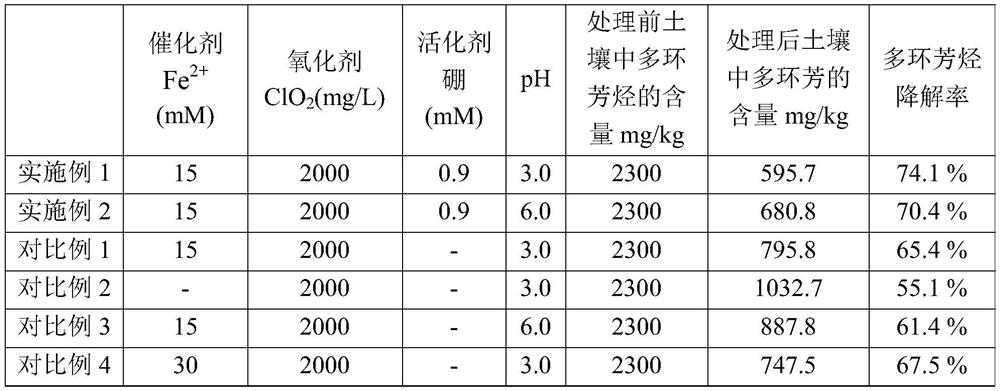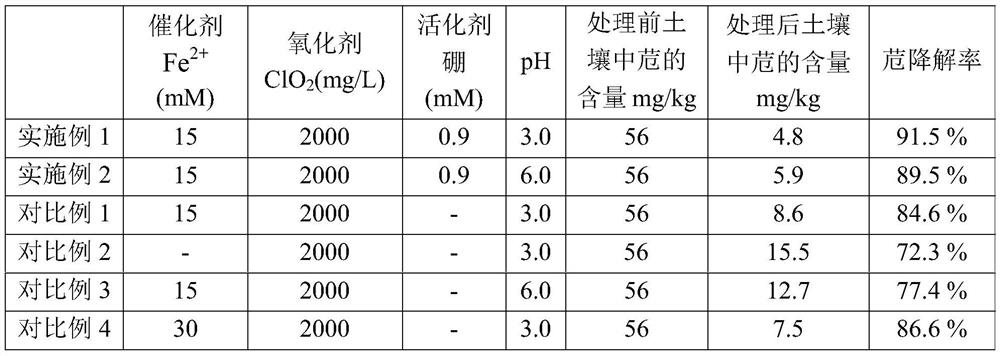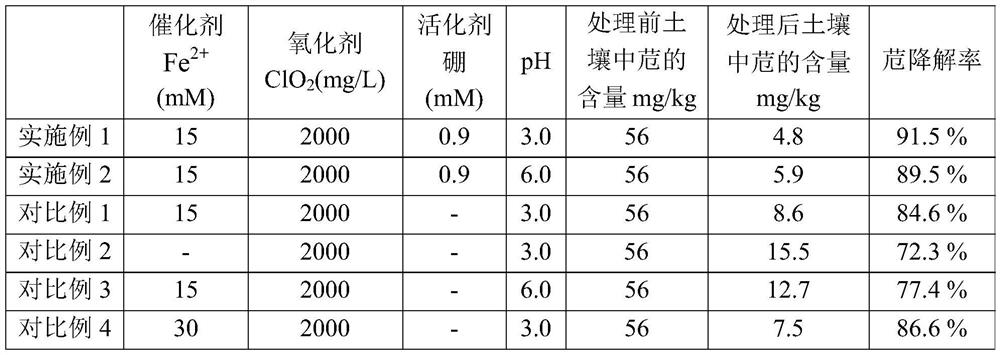Method for degrading pollutants in soil by catalyzing oxidation of chlorine dioxide through boron-activated ferrous ions
A technology that catalyzes chlorine dioxide and oxidative degradation, applied in the field of contaminated soil remediation, can solve the problems that pollutants are not really eliminated, it is difficult to degrade high-concentration contaminated soil, and it is difficult to reuse biological land, etc., and achieve good degradation effect. Good catalytic effect and avoid secondary pollution
- Summary
- Abstract
- Description
- Claims
- Application Information
AI Technical Summary
Problems solved by technology
Method used
Image
Examples
Embodiment 1
[0025] In this embodiment, the method for catalyzing and activating chlorine dioxide to oxidize and degrade pollutants in soil specifically includes the following steps:
[0026] 1. Take by weighing 0.5g of the polluted soil containing polycyclic aromatic hydrocarbons after crushing and screening (the particle size is 0.25mm, the mass content of polycyclic aromatic hydrocarbons is 2300mg / kg, including 16 kinds of polycyclic aromatic hydrocarbons such as anthracene, naphthalene and phenanthrene) in 40mL dark brown glass bottle.
[0027] 2. Prepare the prepared catalyst Fe 2+ Both the pH of the solution and the oxidant chlorine dioxide solution were adjusted to 3.0.
[0028] 3. Add catalyst Fe to the glass bottle 2+ Solution, oxidant chlorine dioxide solution and activator boron, wherein the catalyst Fe 2+ The concentration of the system solution is 15mM, the concentration of chlorine dioxide in the system solution is 2000mg / L, the dosage of boron is 0.9mM, and the total solu...
Embodiment 2
[0033] In this embodiment, the method for catalyzing and activating chlorine dioxide to oxidize and degrade pollutants in soil specifically includes the following steps:
[0034] 1. Take by weighing 0.5g of the polluted soil containing polycyclic aromatic hydrocarbons after crushing and screening (the particle size is 0.25mm, the mass content of polycyclic aromatic hydrocarbons is 2300mg / kg, including 16 kinds of polycyclic aromatic hydrocarbons such as anthracene, naphthalene and phenanthrene) in 40mL dark brown glass bottle.
[0035] 2. Prepare the prepared catalyst Fe 2+ The pH of the solution and the oxidant chlorine dioxide solution prepared by the sodium chlorite-sulfuric acid method are all adjusted to 6.0.
[0036] 3. Add catalyst Fe to the glass bottle 2+ Solution, oxidant chlorine dioxide solution and activator boron, wherein the catalyst Fe 2+ The concentration of the system solution is 15mM, the concentration of chlorine dioxide in the system solution is 2000mg / ...
PUM
| Property | Measurement | Unit |
|---|---|---|
| Particle size | aaaaa | aaaaa |
Abstract
Description
Claims
Application Information
 Login to View More
Login to View More - R&D
- Intellectual Property
- Life Sciences
- Materials
- Tech Scout
- Unparalleled Data Quality
- Higher Quality Content
- 60% Fewer Hallucinations
Browse by: Latest US Patents, China's latest patents, Technical Efficacy Thesaurus, Application Domain, Technology Topic, Popular Technical Reports.
© 2025 PatSnap. All rights reserved.Legal|Privacy policy|Modern Slavery Act Transparency Statement|Sitemap|About US| Contact US: help@patsnap.com



